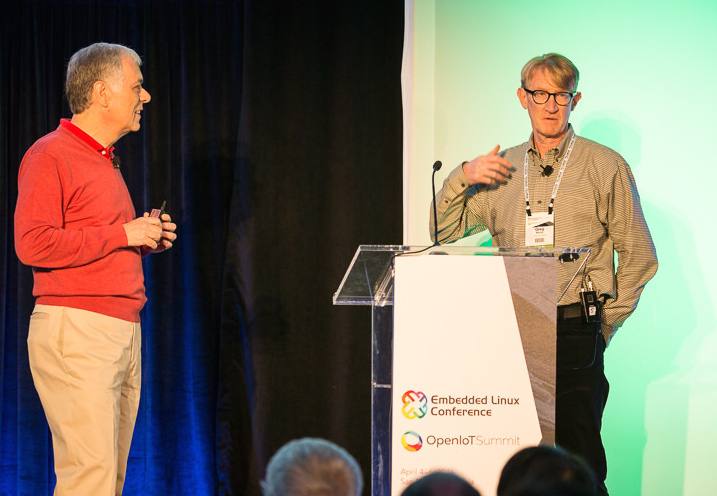In his keynote address at the Embedded Linux Conference’s OpenIoT Summit, Open Connectivity Foundation (OCF) Executive Director Mike Richmond discussed the potential for interoperability — and a possible merger — between the two major open source IoT frameworks: the OCF’s IoTivity and the AllSeen Alliance’s AllJoyn spec. “We’ve committed to interoperability between the two,” said Richmond, who went on to explain how much the two Linux Foundation hosted specs had in common.
Richmond also seemed open to a merger, although he framed this as a more challenging goal. “The political part of this is going to be with us even if we make the technical problem less severe,” he said.
The launch of the OCF in February was seen as a major victory for IoTivity in its competition with AllSeen and other IoT groups. IoTivity emerged in July, 2014, from the Open Interconnect Consortium (OIC), with members including Intel, Atmel, Dell, and Samsung. OIC and IoTivity arrived seven months after The Linux Foundation joined with Qualcomm, Haier, LG, Panasonic, Sharp, Cisco, and others to found the AllSeen Alliance, built around Qualcomm’s AllJoyn framework. Shortly before OIC was formed, Microsoft joined AllSeen.
In November of 2015, OIC acquired the assets of the Universal Plug and Play (UPnP) Forum, and in February of this year, OIC morphed into OCF. The transition was notable not only for the fact that OCF would be hosted by The Linux Foundation, which already sponsored AllSeen, but that Qualcomm, Microsoft, and Electrolux had joined the group.
The three companies remain AllSeen members, but the cross-pollination increased the potential for a merger between the groups — or if not, perhaps the rapid decline of AllSeen. Behind the scenes, a big change from OIC to OCF is the emergence of a new plan for adjudicating intellectual property claims within an open source framework, as detailed in this February VDC Research report.
In Richmond’s keynote, he explained why strong interoperability was so important. Without better standardization, it will be impossible to achieve the stratospheric expectations for the IoT market, he said. “There simply aren’t enough embedded engineers around to make customized solutions.”
In Richmond’s view, IoTivity and AllSeen are both well-suited to bring order to the fractured IoT world because they’re horizontal, mostly middleware-oriented frameworks. Both are agnostic when it comes to OSes on the one hand or wireless standards on the other.
“Maybe the radios have to be different down there or maybe it doesn’t even have to be a radio, but is it that different in the middle?” said Richmond, pointing to an architecture diagram. “That’s why we picked out this horizontal slice. We think there is a lot of commonality across markets and geographies.”
Richmond noted that neither group is dominated by a single tech giant, and that they have similar approaches to open source governance. “What we have in common is the belief that multiple companies should decide how IoT works, not just one,” said Richmond. Pointing to the success of the W3C Consortium, he added: “In the long run, we think that horizontal standards plus open source is what wins.”

The goals of the OCF and AllSeen are the same, argued Burns. “It’s the idea of having standardized data models and wire protocols, proximal first, with cloud connectivity,” he said. “There’s a lot of common terminology and agreement on the approach. They both use IP multicast for discovery.”
The specifics of the wire protocol “don’t matter that much,” continued Burns, and the same goes for some other components. “We can argue about whether object-oriented is better than a RESTful architecture, but ultimately it comes down to personal preferences,” he said. “My vision is that if we were to bring the components of each of these technologies together, we would evolve something that is better than either individually. We really do benefit as an industry and community if we have one standard, and my hope is that we can get there.”
“That’s my hope, too,” added Richmond.
In another ELC presentation, called “AllSeen Alliance, AllJoyn and OCF, IoTivity — Will We Find One Common Language for Open IoT?,” Affinegy CTO Art Lancaster seemed to agree that a high degree of interoperability was possible — but not at the expense of killing off AllSeen. Affinegy, which has developed the “Chariot” IoT stack, has been a major cheerleader for AllSeen, and Lancaster emphasized that AllSeen has a big lead in certifications compared to Iotivity.
I asked Philip DesAutels, senior director of IoT for The Linux Foundation, about the potential for interoperability or merger, and he had this to say. “The easiest and most enduring route to achieving a real and lasting IoT is one common framework,” said DesAutels. “That means bringing together disparate communities each with their own divergent approaches. Convergence and unification are key, but compromise and understanding take time.” DesAutels also noted the importance of the open source Device System Bridge contributed by Microsoft to the AllSeen Alliance, enabling AllJoyn® interoperability with IoTivity and other IoT protocols.”
Both Richmond and Lancaster made it clear that there are many dozens of other overlapping IoT interoperability efforts that must also be considered in developing a universal standard. At ELC, Intel’s Bruce Beare gave a presentation on one of the, Google’s open source Weave framework. Meanwhile, Samsung’s Phil Coval delivered a presentation on integrating IoTivity with Tizen, which Samsung is increasingly aiming at IoT.
Watch the full video below.
Watch all 150+ session videos from Embedded Linux Conference + OpenIoT Summit North America.

